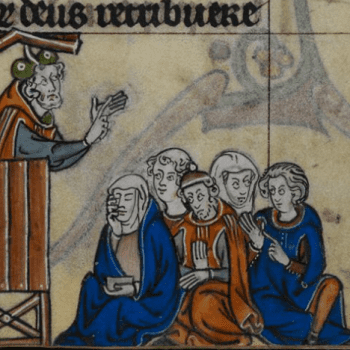In 1891, the British whaling ship Star of the East was slammed by the tale of a harpooned sperm whale somewhere near the Falkland Islands. Two of the sailors, including a man named James Bartley, fell over board. The whale soon died from the harpoons and the sailors, unable to find their capsized crewmates, began harvesting the enormous carcass. This was a long, messy process. It wasn’t until the next day that the whalers dragged the stomach onto the deck. In what might have been the shock of their lives, the sailors found inside the belly of the whale the presumed dead James Bartley. Bartley was traumatized but alive and well. He resumed his normal duties aboard the ship three weeks later and lived for another eighteen years.
Or so goes the story….
I usually hear references to this story once or twice a year (sometimes more)–in a sermon, Sunday School lesson, devotional, or just conversation. Its popularity isn’t surprising. The excitement and mystery of the ocean, the danger of the wounded whale, the miraculous survival, and of course the overt biblical parallel makes this story perfect for church.
Except that it isn’t true.
Despite continuing claims of authenticity, such as by J. Stephen Lang in his 2009 Talking Donkeys and Wheels of Fire: Bible Stories that are Truly Bizarre, Henry Morris and Martin Clark in The Bible Has the Answer (also referenced by christiananswers.net), Don Stewart in an article on BlueLetterBible.org, and the untold number of sermons and Sunday School lessons that rely on it to wow audiences, the story of James Bartley as a “modern-day Jonah” is false.
In A Pastor’s Quick Guide to Historical Research, I outlined a basic methodology for checking sources. But in reviewing the story of James Bartley, I realized I should emphasize one more point: the importance of the historical conversation.
Let me explain.
When I begin checking the James Bartley story, I did two basic searches–one in google and one in google books. I simply searched for “James Bartley” and “James Bartley man swallowed by whale.” What I found was revealing.
The majority of relevant google search results cast doubt on the authenticity of the Bartley story. Most of these did so by discussing (at least in a limited way) both the ‘primary’ sources relevant to Bartley and the evaluation of those primary sources by modern scholarship. Instead of taking the primary accounts at face value, these blogs and articles explored a little further to see how the primary accounts had been analyzed and interpreted by scholars. In other words, they followed the unfolding of the historical narrative about Bartley from its early stages to the late twentieth century. Most of them cited or alluded to a 1991 article by Edward Davis, a professor of Science and History at Messiah College, who wrote “A Whale of a Tale: Fundamentalist Fish Stories,” in Perspectives on Science and Christian Faith 43 (1991): 224-37. Davis traced the Bartley story to the late nineteenth century, concluding that it is not substantiated by historical evidence. Indeed, Davis even found that the 1906 author of The Expository Times article about Bartley expressed difficulty in establishing proof for the tale.
In contrast, the websites and books that accept the Bartley story–and I was surprised by how many books continue to reiterate this story as ‘true’–either cite no sources or cite only sources from the early part of the historical conversation. The favorite primary sources used for verification are an article in the 1891 issue of the Yarmouth Mercury, the February 11 1928 Daily Telegraph, a 1914 French journal article by Henri de Parville, and a 1928 article in the Princeton Theological Review . Unfortunately these early articles contain very little historical evidence to support their claims (see Davis) and mostly seem to build from one another.
What is our lesson? I think it is twofold.
First, checking sources should include attention to the historical conversation. The Bartley conversation changed considerably from the first half of the twentieth century to the later half as scholars began to scrutinize the early stories and trace the evolution of the tale. It is telling that contemporary accounts ‘agreeing’ with the Bartley tale cite mostly the first part of the historical conservation while those who question, or at least hesitate, about its authenticity take more recent scholarly assessments into account.
Second, I think there is a very clear lesson here for pastors and teachers to be careful about the stories they incorporate from commentaries, conversations, and bible tracts. A discussion thread on www.spearboard.com shows how dangerous unsubstantiated tales can be. The post debunks the James Bartley Story. Unfortunately it starts with this question: “A co-worker told me about this story his Pastor told at Church?”
I think that sums up my point.












